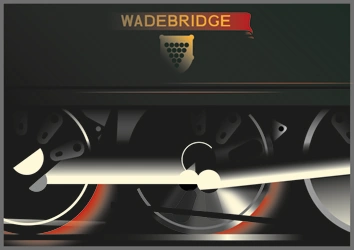The Wadebridge Story
WADEBRIDGE was designed by O V S Bulleid, Chief Mechanical Engineer for the Southern Railway, and was built at Brighton in 1945 as one of the first batch of "West Country" class 4-6-2 mixed traffic locomotives, a smaller version of his "Merchant Navy" express passenger locomotive, leaving the works in August as 21C107 (2 leading, 1 trailing, 3 driving wheels per side, locomotive number 107 in the 21C series) and venturing west to Wadebridge for her official naming ceremony on 31st October of that year. She is the oldest surviving "West Country" class locomotive.
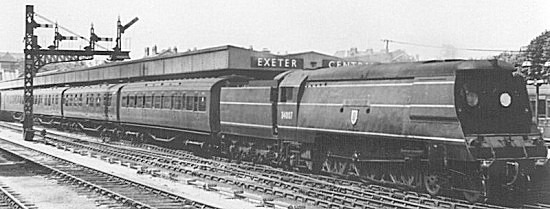
WADEBRIDGE at Exeter Central on 25th June 1949 having arrived with the North Cornwall portion of the up "Atlantic Coast Express". The signal is "off" for her to draw away with the first coach (provided for passengers to Exeter only) leaving the remainder to be combined with the rest of the train for the journey to Waterloo. She still has the three Southern Railway style yellow stripes (also used in early BR days) whilst carrying her BR number on the cabsides but has lost the "BRITISH RAILWAYS" from her tender prior to the availability of transfers for the British Railways Crest. The above photograph also features on page 36 of Stephen Austin's book "The Southern Railway's Withered Arm".
Photo © Sid Nash
Allocated from new to Exmouth Junction shed, her early years were spent in the West Country (after nationalisation of the railways bearing the prefixed number s21C107 from January 1948, with the legend BRITISH RAILWAYS on her tender, and the more normal number 34007 from March 1949) until 11th April 1951 when she moved to Nine Elms, the shed for Waterloo, at which time she was re-painted in standard BR Brunswick Green and her cab modified to wedge-shaped. Whilst at Nine Elms she operated mainly on the old LSWR tracks to Bournemouth, Weymouth and Salisbury, frequently to be seen on Ocean Liner special trains, and was even known to have worked "The Royal Wessex" - a Merchant Navy preserve!
The West Country class locos had many revolutionary design features, but some of these were not successful and the engines proved expensive to operate. As a result many of the class were rebuilt in the 1950s, though WADEBRIDGE avoided that fate.
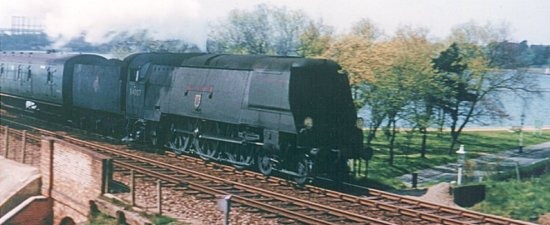
Still sporting the "Cycling Lion" early BR totem on her tender WADEBRIDGE passes Poole Park with an up train in the late 1950's.
Photo © Peter Luxton
Paired from new with tender 3268, this was changed for tender 3266 at Exmouth Junction on 31st July 1947, and this tender was modified in December 1962 to the cut-down state seen in the photograph below. 14th September 1964 saw her transferred to Salisbury shed for her final few months. A sad duty for WADEBRIDGE was performed on 26th April 1965 when she was noted in The Railway Magazine to have hauled withdrawn locomotives 31799, 34031 TORRINGTON, 35024 EAST ASIATIC COMPANY and 80087 from Eastleigh towards the scrapyard. Then, on 7th October 1965, it was her turn and she was sold to Woodhams scrapyard in South Wales, having escaped the BR rebuilding that was the fate of many of her class (and, incidentally, added 4 tons to the weight thus barring the locos from the North Devon and Cornwall lines). Fortunately Woodhams was more interested in cutting up old wagons than locomotives so she languished in the yard until 1981, at which date she was purchased for preservation.
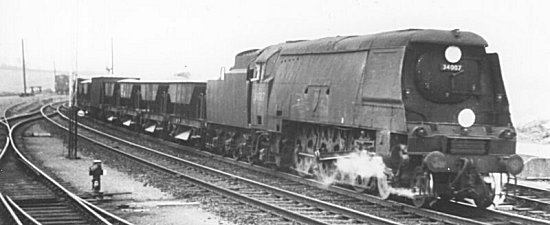
A rather grubby WADEBRIDGE at Honiton towards the end of her short working life on 8th May 1965 with an up Meldon ballast working.
Photo © Michael Messenger
First bought by the Plym Valley Railway, WADEBRIDGE was then sold to a group of enthusiasts who had formed a small company, Wadebridge (34007) Locomotive Ltd., with the sole aim of restoring her to traffic. The road was long and winding but after more than 25 years the goal of returning her to traffic was achieved. Initially based in Plymouth, WADEBRIDGE returned to her "Home County" of Cornwall to a site made available by Fitzgerald Lighting of Bodmin, alongside the Bodmin and Wenford Railway, at a peppercorn rent. Progress was slow but steady, with the usual problems associated with a project of this magnitude. First a shed needed to be constructed in which to carry out most of the work. This was a seemingly flimsy affair, with not a few "peep-holes", but withstood the ravages of the weather well, even the winds of January 1998 which gusted up to 103 m.p.h. at nearby Davidstow.
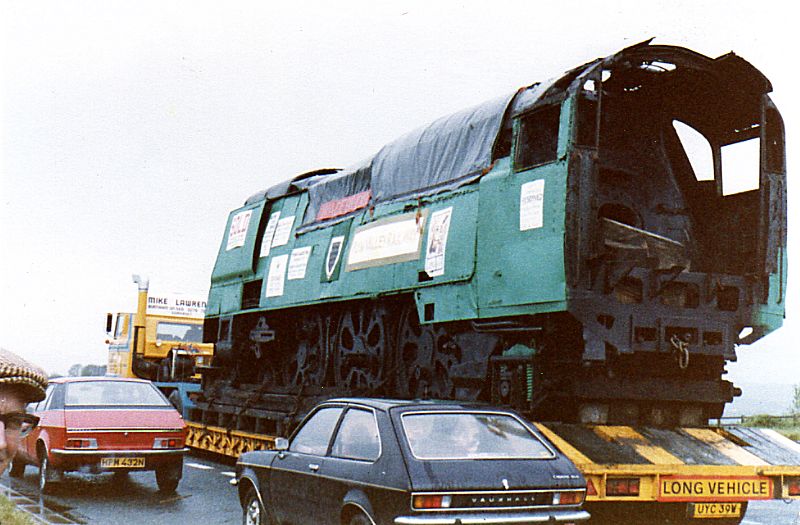
WADEBRIDGE en route from Barry Island to Plymouth. When she arrived she was greeted by quite a party! A police car led the way through the streets of Plymouth whilst a marching band brought up the rear. Amongst the hundreds of well-wishers were Danny La Rue and a local lass, Caroline Seward, a previous Miss United Kingdom.
Photo © A McGlasham.
Work on the engine progressed (although for a long time she looked like a "kit of parts" with every item, no matter how large or small, meticulously labelled) to the stage where the rolling chassis was completed and the task of "putting her back together again" began in earnest. To aid this, the rolling chassis was moved to the workshops at Bodmin General station on 1st December 2001, where the rebuilding was completed. The boiler was moved down in October 2003 and was replaced on the frames in November 2003.
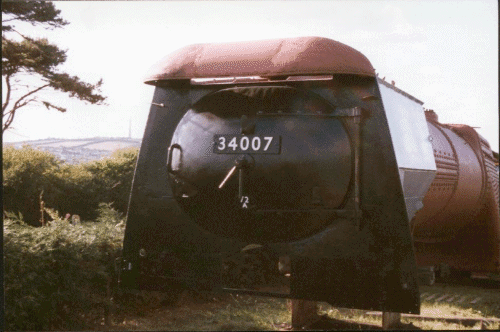
The boiler and smokebox sitting out in the open at Fitzgerald Lighting.
Photograph by Dave Williams.
An unsuccessful application was made for lottery funding (too many Bullied Pacifics surviving!) so all the cost has to be found from donations, our share issue, events and the sale of WADEBRIDGE merchandise.
Work (and fundraising) continued and the locomotive slowly started to resemble a Bulleid pacific once more. 30th August 2006 saw a milestone event in the restoration with a successful steam test of the boiler and fittings taking place.
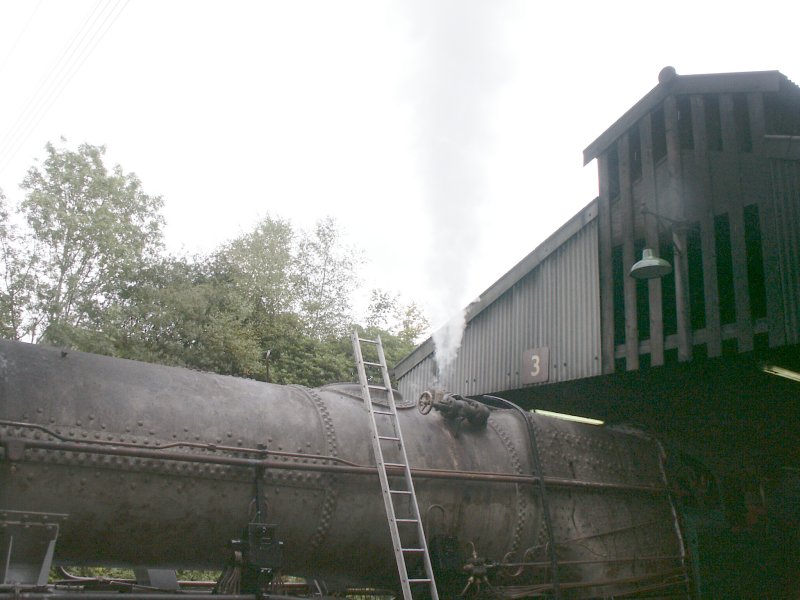
Thar she blows! With 248 lbs of pressure on the dial a safety valve lifts and sends a plume of steam towards the heavens.
Photograph by Peter Richards.
From that moment the ten year boiler certificate started ticking away! Then on 2nd October the locomotive, with casing still incomplete, successfully made her first trip to Boscarne Junction and back, followed by a trip to Bodmin Road and back on 5th October.
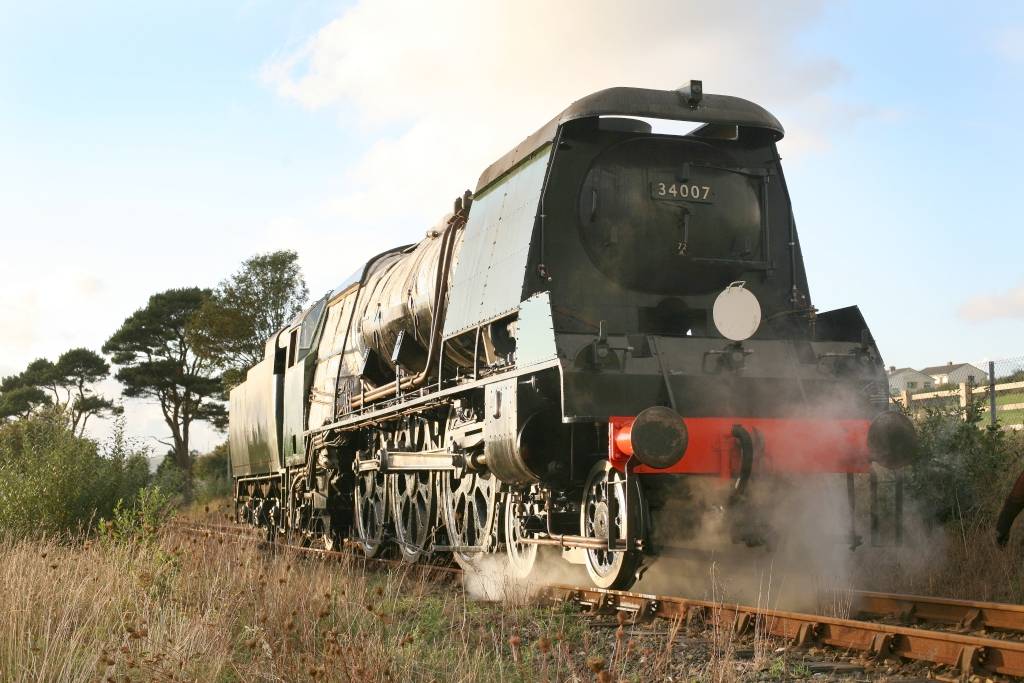
WADEBRIDGE pauses for an inspection and lubrication stop on her trip to Boscarne Junction and back.
Photograph by Sam Felce.
Fitting, painting and fettling contined throughout October until on Sunday, 29th October 2006 the locomotive hauled a special train of invited guests to mark her renaming ceremony at Bodmin General station that afternoon with the unveiling of her new nameplates performed jointly by the mayors of Bodmin and Wadebridge, Cllr Lance Kennedy and Cllr Nick Saunders.
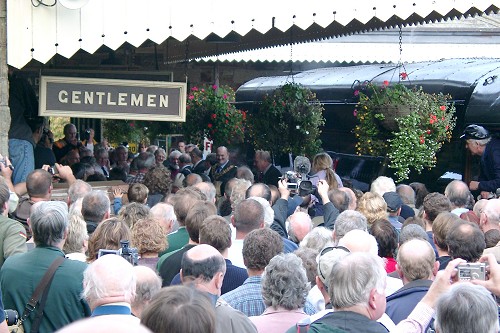
Cllrs Lance Kennedy and Nick Saunders, the Mayors of Bodmin and Wadebridge, perform WADEBRIDGE's renaming at a very crowded Bodmin General station on 29th October 2006.
Photo © Andrew Chalmers-Stevens
The very next day WADEBRIDGE was the subject of a Martin Creese photographic charter.
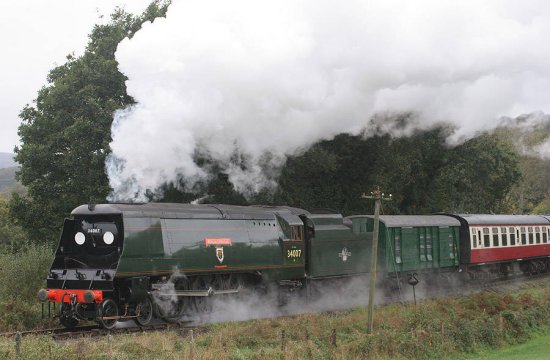
WADEBRIDGE storms by with the photo charter on 30th October 2006.
Photo © Tony Pearce
There followed a short period of operating on the Bodmin and Wenford Railway, then a very successful visit to the West Somerset Railway for their Steam Gala in March 2007.
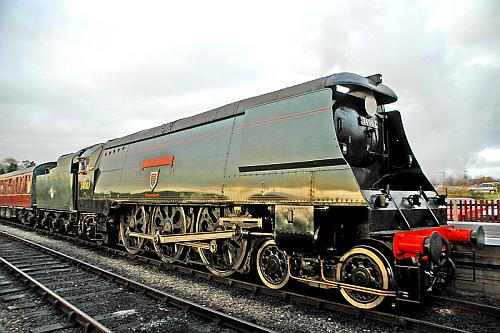
A gleaming WADEBRIDGE sits at the front of her train on arrival at Bishops Lydeard station on 17th March 2007.
Photo © Mark Pike
After her visit to the West Somerset WADEBRIDGE was hired to the Mid-Hants Railway for a year from 1st April. She paid two more visits to other railways during this time, to the Gloucestershire and Warwickshire Railway during June 2007 and to the Bluebell Railway for that line's "Giants of Steam" Gala, where she lined up with three other Bulleid light pacifics, in October 2007.
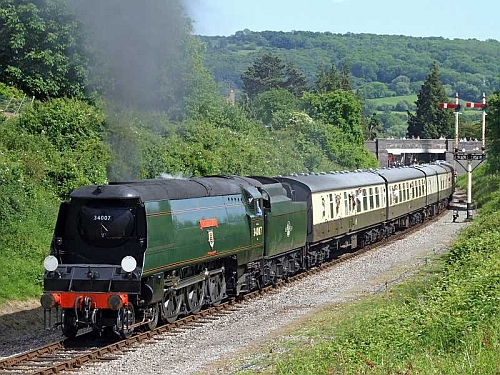
WADEBRIDGE leaving Winchcombe on the GWR on Saturday, 2nd June 2007.
Photo © Steve Bottrill
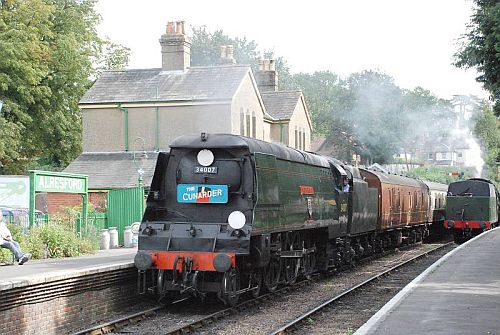
WADEBRIDGE at Alresford on the Mid-Hants Railway on 21st September 2007 with a recreation of the "Cunarder" train that operated for passengers of that line. Pity about the coaches.
Photo © Chris Jones
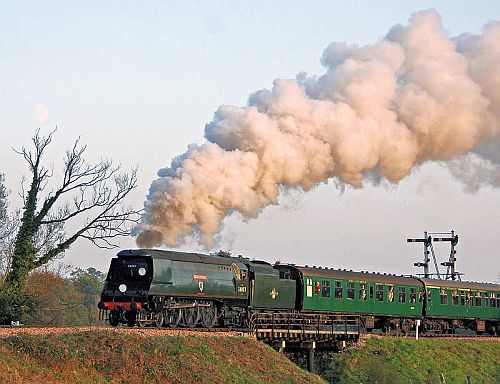
WADEBRIDGE leaves Sheffield Park with a train for Kingscote on 21st October 2007. Correct green coaches here, though only MkIs!
Photo © Derek Hayward
Shortly after this, however, it all went pear-shaped! Back at the Mid-Hants Railway some flamable material was left on the footplate overnight, with the engine in light steam, leading to the unfortunate events of 31st December 2007 when the material caught light, causing a fire that destroyed the cab. The damage was severe but was covered by the Mid-Hants Railway's insurance so repairs were effected as soon as possible. Unfortunately due to the nature of the equipment on a steam engine there was a delay whislt items were sourced or refurbished, but by April the work was done, with the engine returning to traffic on 13th of that month. One beneficial side-effect of all this was that the tender had also suffered some superficial damage and needed a re-paint. The tender (hired from another group) was in pretty poor condition, especially the paintwork, so after the fire the pristine engine was matched with a similarly painted tender for the first time.
The light pacifics fall into two "classes", though there is no difference between "West Country Class" and "Battle of Britain Class" locomotives other than the style and shape of their nameplates and shields. The idea was that the former were originally to be allocated to the south west division of the Southern Railway and subsequently named after towns in the area they worked whilst "Battle of Britain" locos were tp be allocated to the Kent main line and gained the names of RAF squadrons and personnel that distinguished themselves in the Battle of Britain, and Sir Winston Churchill. In the event, of course, locos of each "class" worked in the area of the other "class", though WADEBRIDGE herself was never allocated to the south eastern area, despite a false rumour that circulates alleging that she worked the "Golden Arrow"!
Tales abound about Bulleid pacifics catching fire, and of them "spraying" the track with oil. This what the former engineering director Dave Mitchell of Wadebridge (34007) Locomotive Ltd and was responsible for overseeing the restoration of Wadebridge from scrap condition to full operation had to say on this topic.
